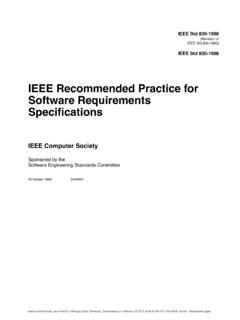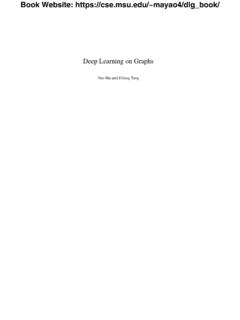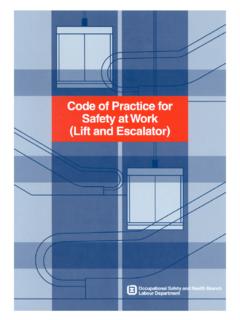Transcription of IEEE Recommended Practice for Software Requirements ...
1 IEEE Std 830-1998 (Revision ofIEEE Std 830-1993) IEEE Std 830-1998 IEEE Recommended Practice for Software Requirements Specifications IEEE Computer Society Sponsored by the Software Engineering Standards Committee 20 October 1998SH94654 Authorized licensed use limited to: Michigan State University. Downloaded on February 23,2010 at 09:32:48 EST from IEEE Xplore. Restrictions apply. The Institute of Electrical and Electronics Engineers, East 47th Street, New York, NY 10017-2394, USAC opyright 1998 by the Institute of Electrical and Electronics Engineers, rights reserved. Published 1998. Printed in the United States of 0-7381-0332-2No part of this publication may be reproduced in any form, in an electronic retrieval system or otherwise, without the prior written permission of the Std 830 -1998(R2009)(Revision ofIEEE Std 830-1993)IEEE Recommended Practice for Software Requirements SpecificationsSponsorSoftware Engineering Standards Committeeof theIEEE Computer SocietyReaffirmed 9 December 2009 Approved 25 June 1998 IEEE-SA Standards BoardAbstract: The content and qualities of a good Software Requirements specification (SRS) are de-scribed and several sample SRS outlines are presented.
2 This Recommended Practice is aimed atspecifying Requirements of Software to be developed but also can be applied to assist in the selec-tion of in-house and commercial Software products. Guidelines for compliance with are also : contract, customer, prototyping, Software Requirements specification, supplier, systemrequirements specificationsAuthorized licensed use limited to: Michigan State University. Downloaded on February 23,2010 at 09:32:48 EST from IEEE Xplore. Restrictions apply. IEEE Standards documents are developed within the IEEE Societies and the Standards Coordinating Committees of theIEEE Standards Association (IEEE-SA) Standards Board. The IEEE develops its standards through a consensus develop-ment process, approved by the American National Standards Institute, which brings together volunteers representing variedviewpoints and interests to achieve the final product.
3 Volunteers are not necessarily members of the Institute and serve with-out compensation. While the IEEE administers the process and establishes rules to promote fairness in the consensus devel-opment process, the IEEE does not independently evaluate, test, or verify the accuracy of any of the information containedin its of an IEEE Standard is wholly voluntary. The IEEE disclaims liability for any personal injury, property or other dam-age, of any nature whatsoever, whether special, indirect, consequential, or compensatory, directly or indirectly resultingfrom the publication, use of, or reliance upon this, or any other IEEE Standard IEEE does not warrant or represent the accuracy or content of the material contained herein, and expressly disclaimsany express or implied warranty, including any implied warranty of merchantability or fitness for a specific purpose, or thatthe use of the material contained herein is free from patent infringement.
4 IEEE Standards documents are supplied AS IS. The existence of an IEEE Standard does not imply that there are no other ways to produce, test, measure, purchase, market,or provide other goods and services related to the scope of the IEEE Standard. Furthermore, the viewpoint expressed at thetime a standard is approved and issued is subject to change brought about through developments in the state of the art andcomments received from users of the standard. Every IEEE Standard is subjected to review at least every five years for revi-sion or reaffirmation. When a document is more than five years old and has not been reaffirmed, it is reasonable to concludethat its contents, although still of some value, do not wholly reflect the present state of the art. Users are cautioned to checkto determine that they have the latest edition of any IEEE publishing and making this document available, the IEEE is not suggesting or rendering professional or other servicesfor, or on behalf of, any person or entity.
5 Nor is the IEEE undertaking to perform any duty owed by any other person orentity to another. Any person utilizing this, and any other IEEE Standards document, should rely upon the advice of a com-petent professional in determining the exercise of reasonable care in any given : Occasionally questions may arise regarding the meaning of portions of standards as they relate to specificapplications. When the need for interpretations is brought to the attention of IEEE, the Institute will initiate action to prepareappropriate responses. Since IEEE Standards represent a consensus of concerned interests, it is important to ensure that anyinterpretation has also received the concurrence of a balance of interests. For this reason, IEEE and the members of itssocieties and Standards Coordinating Committees are not able to provide an instant response to interpretation requestsexcept in those cases where the matter has previously received formal consideration.
6 Comments for revision of IEEE Standards are welcome from any interested party, regardless of membership affiliation withIEEE. Suggestions for changes in documents should be in the form of a proposed change of text, together with appropriatesupporting comments. Comments on standards and requests for interpretations should be addressed to:Secretary, IEEE-SA Standards Board445 Hoes LanePiscataway, NJ 08854 USAA uthorization to photocopy portions of any individual standard for internal or personal use is granted by the Institute ofElectrical and Electronics Engineers, Inc., provided that the appropriate fee is paid to Copyright Clearance Center. Toarrange for payment of licensing fee, please contact Copyright Clearance Center, Customer Service, 222 Rosewood Drive,Danvers, MA 01923 USA; (978) 750-8400.
7 Permission to photocopy portions of any individual standard for educationalclassroom use can also be obtained through the Copyright Clearance : Attention is called to the possibility that implementation of this standard may require use of subject mat-ter covered by patent rights. By publication of this standard, no position is taken with respect to the existence orvalidity of any patent rights in connection therewith. The IEEE shall not be responsible for identifying patentsfor which a license may be required by an IEEE standard or for conducting inquiries into the legal validity orscope of those patents that are brought to its licensed use limited to: Michigan State University. Downloaded on February 23,2010 at 09:32:48 EST from IEEE Xplore. Restrictions apply. Copyright 1998 IEEE.
8 All rights reserved. iii Introduction (This introduction is not a part of IEEE Std 830-1998, IEEE Recommended Practice for Software Requirements Specifi-cations.) This Recommended Practice describes Recommended approaches for the specification of Software require-ments. It is based on a model in which the result of the Software Requirements specification process is anunambiguous and complete specification document. It should helpa) Software customers to accurately describe what they wish to obtain;b) Software suppliers to understand exactly what the customer wants;c)Individuals to accomplish the following goals:1)Develop a standard Software Requirements specification (SRS) outline for their own organiza-tions;2)Define the format and content of their specific Software Requirements specifications;3)Develop additional local supporting items such as an SRS quality checklist, or an SRS writer the customers, suppliers, and other individuals, a good SRS should provide several specific benefits, suchas the following: Establish the basis for agreement between the customers and the suppliers on what the softwareproduct is to do.
9 The complete description of the functions to be performed by the Software specifiedin the SRS will assist the potential users to determine if the Software specified meets their needs orhow the Software must be modified to meet their needs. Reduce the development effort. The preparation of the SRS forces the various concerned groups inthe customer s organization to consider rigorously all of the Requirements before design begins andreduces later redesign, recoding, and retesting. Careful review of the Requirements in the SRS canreveal omissions, misunderstandings, and inconsistencies early in the development cycle when theseproblems are easier to correct. Provide a basis for estimating costs and schedules. The description of the product to be developed asgiven in the SRS is a realistic basis for estimating project costs and can be used to obtain approval forbids or price estimates.
10 Provide a baseline for validation and verification. Organizations can develop their validation andverification plans much more productively from a good SRS. As a part of the development contract,the SRS provides a baseline against which compliance can be measured. Facilitate transfer. The SRS makes it easier to transfer the Software product to new users or newmachines. Customers thus find it easier to transfer the Software to other parts of their organization,and suppliers find it easier to transfer it to new customers. Serve as a basis for enhancement. Because the SRS discusses the product but not the project thatdeveloped it, the SRS serves as a basis for later enhancement of the finished product. The SRS mayneed to be altered, but it does provide a foundation for continued production readers of this document are referred to Annex B for guidelines for using this Recommended Practice tomeet the Requirements of IEEE/EIA , IEEE/EIA Guide Industry Implementation of ISO/IEC12207: 1995, Standard for Information Technology Software life cycle processes Life cycle licensed use limited to: Michigan State University.












